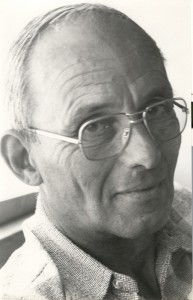Biography
 Born in Millau, in the Aveyron region, on November 8, 1910.
Born in Millau, in the Aveyron region, on November 8, 1910.
Childhood in Espalion, where painters from several countries spent their summers.
Around 1926, Sahuguet meets Ludo Chauviac, with whom he begins to sketch actively.
1930: Begins art studies at the fine arts school in Bordeaux with Chauviac.
Goes to Paris and is a member of the “Horde du Mont-Parnasse” during what can be called his impressionist period.
Works shown at the Salon des Artistes Français, the Salon d’Hiver, the Salon des Tuileries as well as in London, Ghent, Lyon, Clermont and Strasbourg.
Gold medal at the Salon d’Asnières in 1937. Paris City Council purchases Plaine du Nord.
Marries in the same year.
1939-45: Sent to war, later injured. Awarded the Croix de Guerre.
Takes refuge with his wife in Antoingt, a small village in Auvergne, where he recovers and takes up painting again.
Appearance of a certain degree of surrealism and symbolism in his work. Paints a series of witches and compositions of women wearing old-fashioned gowns; allegories and incarnations of death.
Returns to Paris, studies the techniques of early Netherlandish painting and iconography. Develops an interest in religious art:
– Triptych of the raising of Lazarus (1947)
– Way of the Cross series in Laguiole (1948), oil on wood, commissioned by the French government.
At the same time, develops interest in classical, Spanish, and sacred Hindu dance. .
Receives encouragement from André Malraux during this period.
Begins research into a symbolic and liturgical Art d’Eglise. Studies mural painting techniques of the Cluniac monks and uses a modern version of the products used at the time to paint his first iconographic panels.
Several orders follow for murals :
1953 : Strasbourg Students’ Chapel at Vieil Armand (Haut-Rhin)
1954-55 : Baptistery of the Zillisheim Church and Sainte Geneviève Church in Mulhouse.
1956 : Retable of the Dominique Savio Chapel in Landser (Haut-Rhin)
Debilitated by a heart attack, Sahuguet leaves Paris in 1969 and settles in Montréal de l’Aude, where he takes up easel painting on canvas again and produces still lifes and landscape paintings of the Montréal de l’Aude region.
Returns to symbol-focused creations in 1976, this time drawing on a broader range of inspiration less centered on the Faith.
Paints the Tree of Life symbolic panels on wood.
Panels shown in Geneva at the Galerie Calart, in Paris at the Galerie du Théâtre du Ranelagh, in Saint Maur and Carcassonne. Today many are part of private collections.
Today, 39 of the panels are on permanent display at the Abbaye de Caunes-Minervois.
In 1979 Sahuguet turns to a project he has thought about for a long time: An illustration of the Apocalypse of John in 46 gouaches on paper, completely faithful to the original text. Project receives warm encouragement from Georges DUBY.
Charles Sahuguet passes away in June 1990.
In 1998, the painter’s “Apocalypse of John” is documented in its entirety in a book published by Editions Saint-Augustin in Switzerland.
